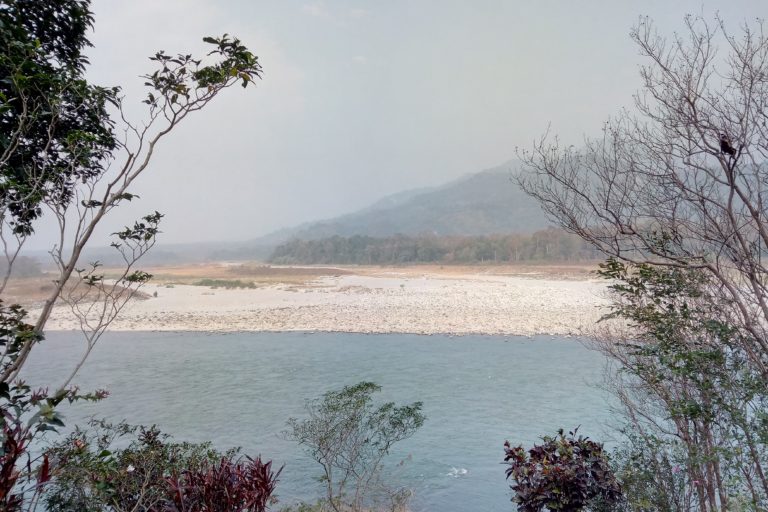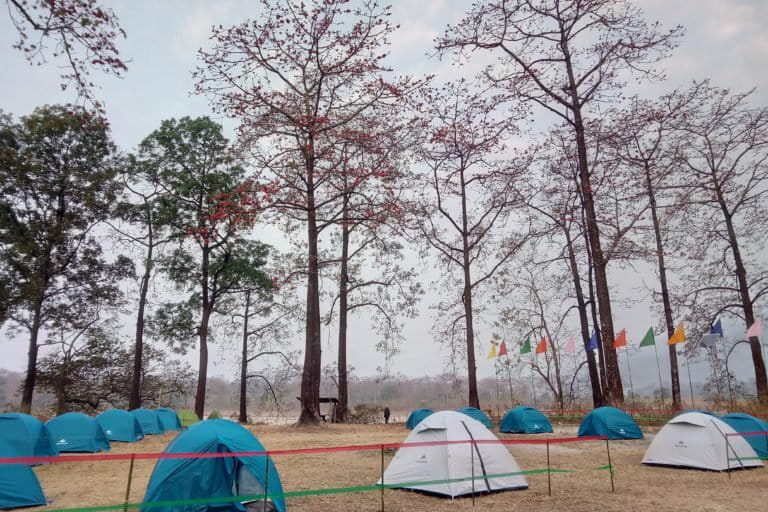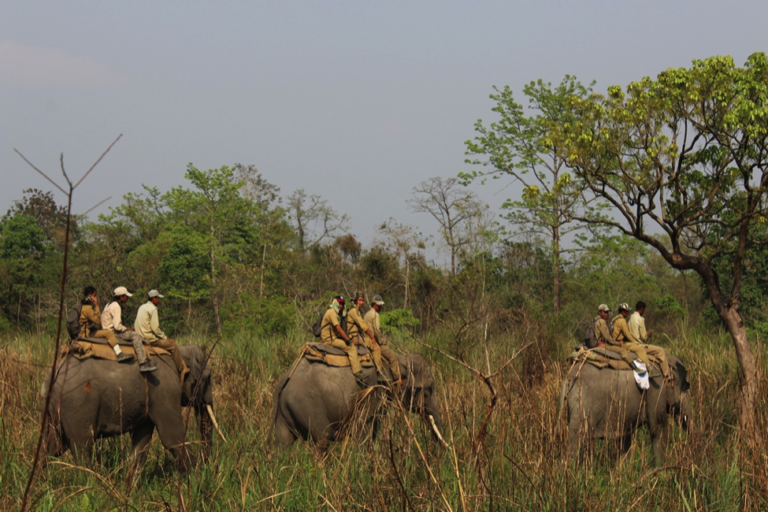- Recurring ethno-political violence around Assam’s Manas National Park (MNP) in the Bhutan-Himalayan foothills from the late 1980s till 2003 changed the spread and abundance of species in the park.
- But the protected area’s continuity with Bhutan’s Royal Manas National Park (RMNP) helped shelter and preserve the overall animal diversity, a new study has said.
- The study mapped the status of the animals in the aftermath of the unrest, underscoring the importance of landscape connectivity for giving a fighting chance to species to survive in the face of conflicts and other disturbances.
Recurring ethno-political violence that rocked Assam’s Manas National Park (MNP), in the Bhutan-Himalayan foothills, from the late 1980s till 2003 changed the spread and abundance of wildlife, including royal Bengal tigers.
But the protected area’s continuity with Bhutan’s Royal Manas National Park (RMNP) helped shelter and preserve the overall animal diversity, a new study has said.
The study that mapped the status of the animals in the aftermath of the unrest, underscored the importance of landscape connectivity for giving a fighting chance to species to survive in the face of conflicts and other disturbances, according to lead author M. Firoz Ahmed.

The MNP (also known as the Manas Wildlife Sanctuary), flanking the banks of the gurgling Manas river, abuts with RMNP in the north and forms an integral part of the Transboundary Manas Conservation Area (TraMCA), an India-Bhutan partnership promoting landscape level ecosystem management.
“If we model our conservation areas in such a way so that animals can move during disturbances and then they can move back to reoccupy their home ranges or territories, then we have a chance to keep the biodiversity intact,” Ahmed, a scientist with NGO Aaranyak, told Mongabay-India.
The TraMCA, conceptualised by officials from the forest department of Assam and Bhutan and partnering NGOs is now a model for international conservation community and is being mainstreamed by both India and Bhutan governments, informed Ahmed.
The study resulted from an extensive camera trapping exercise across the three ranges of the MNP-Panbari, Bansbari and Bhuyanpara. It was only in 2017 that surveys could be undertaken simultaneously across all three ranges of MNP.

The survey confirmed the presence of 25 mammalian species photo-captured in MNP, 13 of which are threatened species (IUCN 2017). Some of them are clouded leopard (vulnerable), Asian elephant (endangered), hog deer (endangered) and swamp deer (vulnerable).
The photo-capture results highlight the fact that “despite a long history of ethno-political conflict in the region, almost all mammalian species expected to occur in the region were present and detected during this study,” with the exception of sloth bear (Melursus ursinus) and fishing cat (Prionailurus viverrinus).
The authors assert that the contiguity within TraMCA certainly has a “positive effect contributing to the repopulation of large carnivores, including tigers, in the aftermath of the conflict as RMNP has acted as a refuge” for the animals displaced by disturbances in MNP.
In fact, tigers are making a comeback in the landscape. From 14 in 2011-2012, the population rose to 21 in 2016. Park officials put the latest figure at 31 as per preliminary findings.

Ahmed said though there is a population loss in this process (when these animals move to other areas, some animals in the new host area may die from fighting, starvation and other factors), when planning conservation, especially for protected areas, connectivity must be incorporated, even on community lands.
In 500 square km sprawl of forests and grasslands, the national park is a world heritage site, harbouring endangered species, such as the tiger, pygmy hog, Indian rhinoceros and Indian elephant.
A part of the core zone of the 2837 square km Manas Tiger Reserve, the park now buzzes with both domestic and international tourists eager to train their cameras on the magnificent rhinos, tigers, wild buffalos and the blink-and-you-miss beautiful birds.

The park saw turbulent days in the 1980s until 2003 following the demand for a separate Bodoland (Bodos are the largest tribal group in Assam) territory in the state.
“During this period the population of Indian rhino (Rhinoceros unicornis) was poached out, necessitating a reintroduction program to repopulate the park,” noted study co-author Dipankar Lahkar. The conflict severely hampered the protection mechanism in place in the park.
“The park protection in Bhuyapara and Panbari were nearly non-existent during and after until 2004-05 when it started picking up. Panbari is still volatile but it is better than it was a decade back,” Ahmed said.
“With no protection, the park natural resources became open to fringe villagers and also to poachers/hunters including small scale hunters and subsistence bushmeat hunters. Other than direct killing all these led to human disturbance in a habitat forcing animals to move away,” he said.
H.K. Sarma, field director of MNP and also a study co-author, emphasised how daunting it was for foresters to re-establish protection.
“When protection in the Manas NP was reestablished around 2003-04 there was hardly any infrastructure in the Bhuyapara and Panbari Range. Due to the frequent attacks on camps by miscreants and killing of staff members, frontline staff were compelled to stay away from their camps over one and half decades,” Sarma told Mongabay-India.
Panbari and Bhuyanpara range bore the brunt of the conflict and the animals, due to lack of security, moved towards the Bansbari range.
The park falls under the Bodoland Territorial Administration Districts (BTAD) that was carved out in western Assam following the resolution of the conflict in 2003 with the formation of the Bodoland Territorial Council (BTC), which provides a certain degree of autonomy to the Bodo people in this area.
Sarma credits his predecessors who worked hard with the (BTC) administration and NGOs to progressively establish protection and motivate communities to come forward to conserve Manas.
Lauding the effort behind the study, Maan Barua, a cultural and environmental geographer from the University of Cambridge, who was not involved in the analysis, said the takeaway from Manas is that it is difficult to practice conservation outside a socio-political realm.
“The prevalence of biodiversity is often a political economic and political ecological question. Abundance is key and the long-term success of the Manas project will be reflected by whether the model in the future delivers social justice and allows for species, whose abundance has decreased, to come back. Efforts like this can only help the cause,” Barua told Mongabay-India.

Camera-traps divulge status
On analysing the data, the researchers discovered that in Bhuyapara and Bansbari range (forest ranges that have been conflict-free since 2003) most species were spread out uniformly while in Panbari (a forest range with conflict until 2016) they are either scanty or some distributed far in the interiors on the border of RMNP.
The photos also revealed that carnivores, such as tigers, are more mobile in Panbari range and on frequent move so they are more photo-captured.
“This means that there are fewer prey animals in Panbari due to the longer disturbance period and the carnivores are moving more and spending more energy to locate prey and hunt. The long conflict has led to reduced number of prey animals in the Panbari range and has not yet built up their population in the range like Bansbari and Bhuyapara relatively peaceful during the last one decade or more,” Ahmed remarked.
Over the last few years (preceding this study) prey population seems to have started building in the Panbari range except for large mammals like sambar, gaur and buffalo which were mapped in significantly low numbers compared to other species, the authors said.
“This further indicates that while villagers were avoiding the Panbari range due to presence of armed militants and security forces operating around, large prey were still disturbed by presence of armed militants and security forces. Often large mammals were reliable protein source for those camping deep inside the range having little or no access to supplies from outside, since their supply lines were severed by security forces. However, there was no direct evidence to this,” Ahmed clarified.
Also a number of tigers photo-captured in RMNP the year before the survey were clicked at Panbari as well, indicating they have got the chance to range further to explore new territories and eventually populate the area that was nearly a void for some time.
“Here RMNP acts as a refuge for many species and hence the diversity of the species known from Manas has not got lost and has remained intact,” Ahmed said.

Embarking on the survey proved challenging to the researchers since they did not have a dataset to compare the diversity and distribution of mammals, before and after the conflict.
“However, we had the list of species found in the park in different ranges. So, we had to find an innovative way to compare the species abundance (we call it relative abundance here) across the ranges to conclude if conflict had an impact on the diversity or status,” Ahmed said.
“We used photo capture rate as index to compare the relative abundance here which is a reliable way to understand relative abundance of species across landscapes or sites.”
Barua observed that camera trapping has much to contribute to understanding patterns of biodiversity, particularly in the case of mammals that are difficult to otherwise spot.
“The species assemblage recorded, particularly the clouded leopard, is of great interest. The late Sanjay Debroy, a stalwart of Assam’s forest department and who was pivotal to conservation in Manas in the 1970s, was one of the few people who had seen this animal. The paper mentions a number of records from camera-traps,” Barua mentioned.

The way ahead
Sarma exuded confidence that once the security of the Panbari range is enhanced the population of different species will bounce back to optimum as seen in the other ranges.
“It is time to act to improve management of the range to the maximum. As the situation improved, animals that moved away from Panbari started to move back.
However, it will take some more time for all wild animals to adjust with the changing situation,” Sarma said. Understanding the importance of TRaMCA, both the park management of MNP and RMNP work very closely with each other, said Sarma.
He stressed on exchanging information and intelligence, on poaching and hunting or other disturbances, to minimise negative impacts on both the parks.
“Poachers were apprehended in Bhutan based on intelligence shared by us while bordering areas are jointly patrolled by staff of both the parks. The mechanism of transboundary collaboration that started some years back is now on ground and this is certainly helping the key threatened species in the entire landscape,” the forest official said.
“As long as the protected forests are there in this landscape, 10 to 15 million people living in western Assam will continue to receive healthy ecological services for better life like water and soil nutrients,” added Ahmed.

CITATION
Lahkar, D., Ahmed, M. F., Begum, R. H., Das, S. K., Lahkar, B. P., Sarma, H. K., & Harihar, A. (2018). Camera-trapping survey to assess diversity, distribution and photographic capture rate of terrestrial mammals in the aftermath of the ethnopolitical conflict in Manas National Park, Assam, India. Journal of Threatened Taxa, 10(8), 12008-12017.
Banner Image: Manas National Park rangers keep vigil over the landscape. Photo by HK Sarma/Manas National Park.
